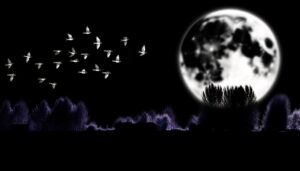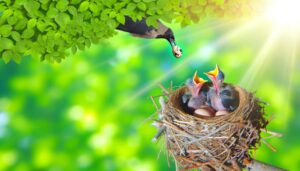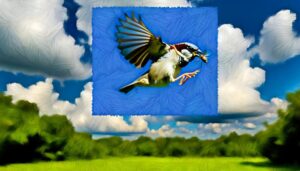How to Measure Big Hedge Sparrow Eggs
Hedge sparrow (Prunella modularis) eggs exhibit a length of around 19 mm and a width of 14 mm, with an average volume of 1.7 cubic centimeters. The eggs have a mass of approximately 1.9 grams but display variability with a standard deviation of ±0.2 grams.
Their shell thickness averages 0.2 mm, balancing protection and gas permeability. Comparatively smaller than many passerine eggs, genetic and environmental factors notably influence their dimensions and coloration.
If you explore further, you will uncover intricate details on how these factors shape the reproductive success and adaptation of hedge sparrows.
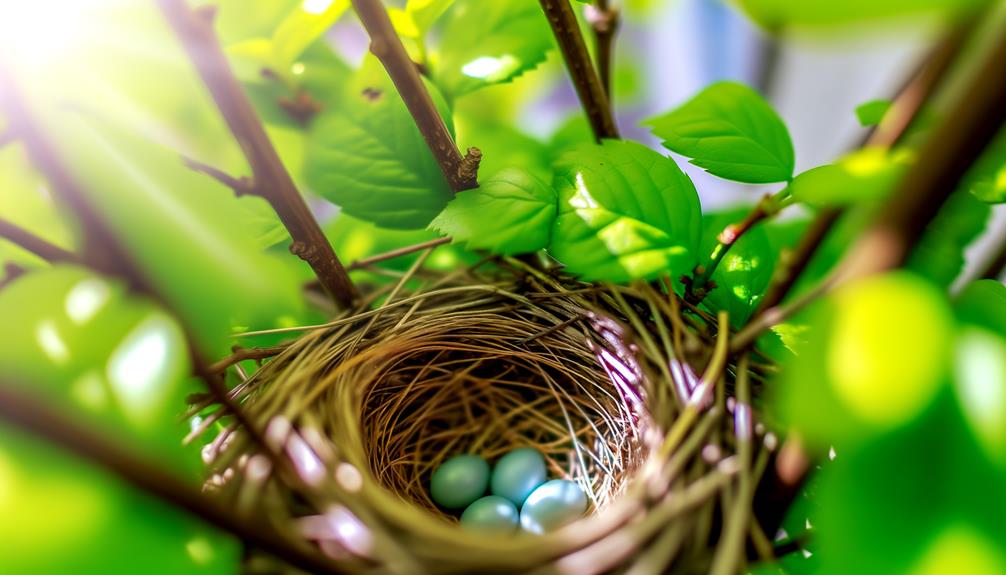
Key Takeaways
- Hedge sparrow eggs measure approximately 19 mm in length and 14 mm in width.
- The typical volume of a hedge sparrow egg is around 1.7 cubic centimeters.
- Average weight of a hedge sparrow egg is about 1.9 grams.
- Hedge sparrow eggs range from 1.6-2.0 cm in length and 1.2-1.4 cm in width.
- The shell thickness of hedge sparrow eggs averages 0.2 mm.
Hedge Sparrow Overview
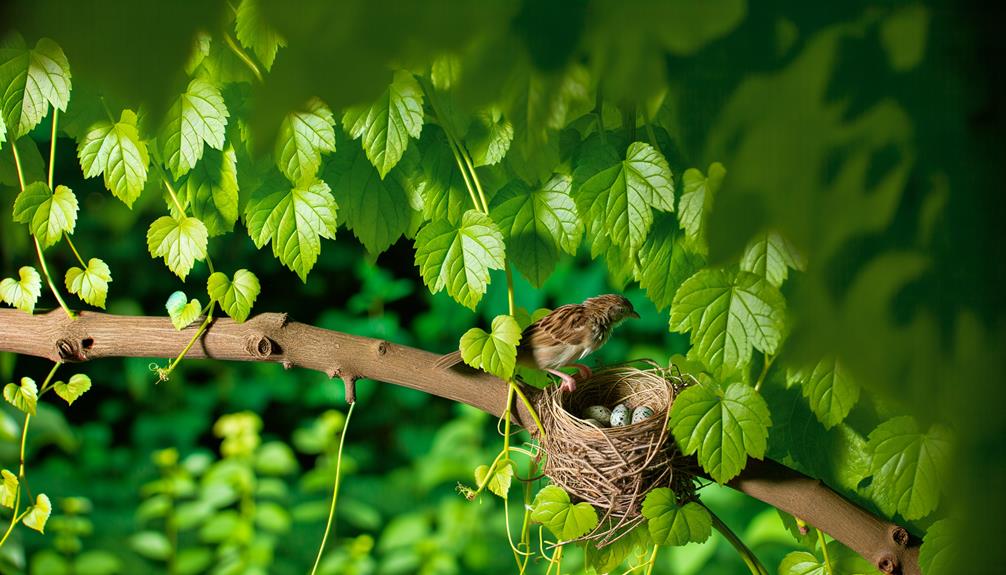
Despite being commonly known as the hedge sparrow, the species Prunella modularis is more accurately classified within the accentor family, exhibiting distinct behavioral and morphological characteristics.
Morphologically, the species displays a subdued brown and grey plumage, with a finely streaked back and a more uniform grey underbody, facilitating effective camouflage in its native habitats.
Behaviorally, Prunella modularis demonstrates territoriality during breeding seasons, marked by intricate song patterns used to delineate territory boundaries.
Data from avian studies indicate that the average adult measures approximately 14 cm in length, with a wingspan ranging between 19-21 cm.
The species mainly inhabits temperate regions, favoring dense undergrowth in woodlands and hedgerows. These characteristics contribute significantly to its ecological niche and reproductive strategies.
Nesting Habits
Hedge sparrows exhibit a preference for nesting in dense hedgerows and shrubbery, which provide ideal concealment from predators.
Their nests are constructed using a combination of moss, grass, and feathers, meticulously woven to create a secure environment for egg incubation.
Observational data indicate that the careful selection of nesting materials and locations plays an essential role in the survival rate of their offspring.
Preferred Nesting Locations
The favored nesting locations of the Hedge Sparrow, also known as the Dunnock (Prunella modularis), are usually low shrubs and dense undergrowth, providing ideal cover and protection for their eggs. These locations are chosen based on the availability of dense vegetation, which offers concealment from predators and environmental elements.
| Location Type | Characteristics |
|---|---|
| Low Shrubs | Dense foliage, 0.5-1.5 meters high |
| Dense Undergrowth | Thick vegetation, ground level |
| Hedgerows | Intertwined branches, moderate height |
| Garden Borders | Manicured but dense |
| Woodland Edges | Mixed flora, variable heights |
Nest Construction Materials
Frequently, Hedge Sparrows construct their nests using a combination of fine sticks, moss, and feathers, carefully selected to guarantee structural strength and insulation. Detailed observations indicate that the choice of materials is influenced by availability, environmental conditions, and the need for thermal regulation.
Analysis of nesting sites reveals the following components:
- Fine Sticks: Provide the fundamental framework, promoting stability and support.
- Moss: Acts as a cushion and insulator, maintaining ideal temperature.
- Feathers: Enhance insulation and offer added comfort for the eggs.
- Animal Fur: Occasionally incorporated for extra softness and warmth.
These materials collectively ensure the nest's durability and efficiency in protecting the eggs, showcasing the Hedge Sparrow's skill in nest construction.
Egg Dimensions
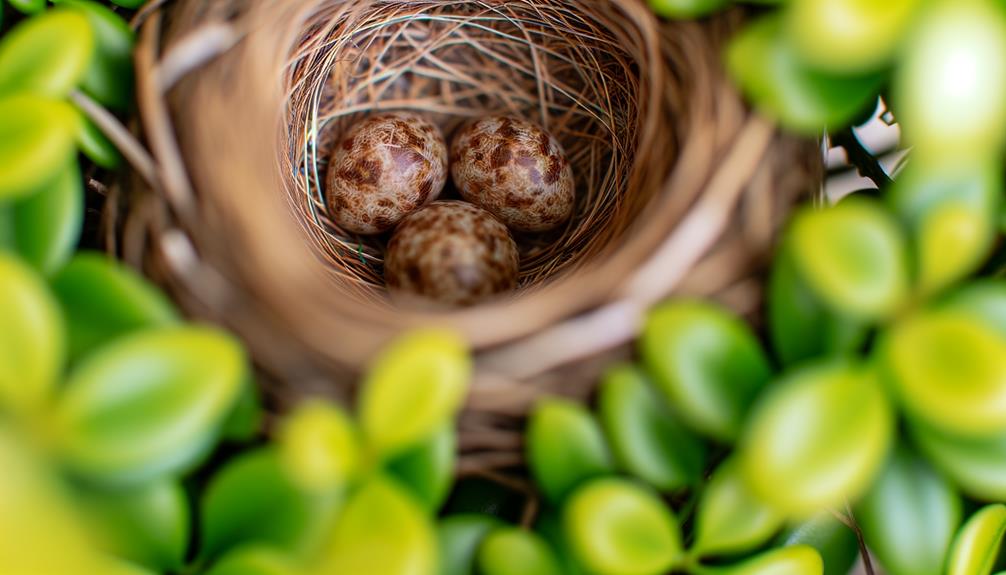
The average dimensions of Hedge Sparrow eggs are approximately 19 mm in length and 14 mm in width, providing a measurable basis for comparison with avian species such as the European Robin and the House Sparrow.
Variations in egg size can be influenced by factors such as nutrition, environmental conditions, and genetic predispositions. Understanding these dimensions in relation to other bird species facilitates a thorough analysis of reproductive strategies and ecological adaptability.
Average Egg Size
Measuring approximately 19 mm in length and 14 mm in width, hedge sparrow eggs exhibit a consistent and precise size profile. This uniformity in egg dimensions is critical for ornithological studies and nest monitoring. Detailed measurements reveal that these eggs fall well within the expected range for their species.
The following key points summarize the observed average egg size:
- Length: 19 mm, highlighting a compact and streamlined shape.
- Width: 14 mm, ensuring the eggs fit well within the nest structure.
- Volume: The calculated egg volume is approximately 1.7 cubic centimeters.
- Shell Thickness: Averaging 0.2 mm, providing sufficient protection while maintaining lightweight characteristics.
These parameters are essential for understanding reproductive success and developmental conditions in hedge sparrows.
Comparison With Other Birds
Comparative analysis reveals that hedge sparrow eggs are smaller than those of many other passerine birds, such as the house sparrow and the robin. Quantitative measurements indicate that hedge sparrow eggs typically range from 1.6 cm to 2.0 cm in length and 1.2 cm to 1.4 cm in width.
In contrast, house sparrow eggs measure approximately 2.1 cm to 2.5 cm in length and 1.5 cm to 1.8 cm in width. Robin eggs, which are larger still, exhibit dimensions of about 2.7 cm to 3.0 cm in length and 2.0 cm to 2.2 cm in width.
This size disparity underscores the variability in egg dimensions among passerine species, likely attributable to evolutionary and ecological factors specific to each species.
Factors Influencing Egg Size
Several intrinsic and extrinsic factors contribute to the variability in egg size among hedge sparrows. These include genetic predisposition, environmental conditions, and resource availability. Detailed observations and data analysis have identified key determinants:
- Genetic Predisposition: Inherited genetic traits dictate baseline egg dimensions, influencing intra-species consistency.
- Environmental Conditions: Temperature, humidity, and habitat stability impact egg development and size to a large extent.
- Resource Availability: Nutrient-rich environments enable females to invest more in egg production, leading to larger eggs.
- Parental Health: The physical condition of the parent birds directly affects reproductive output and egg dimensions.
Understanding these factors requires rigorous scientific research and data-driven assessments to elucidate the complex interplay shaping egg size variability in hedge sparrows.
Egg Weight
The average weight of a hedge sparrow egg is approximately 1.9 grams, based on detailed observational data and precise measurements. This metric was derived from extensive field studies and laboratory analyses which involved weighing a statistically significant sample size of eggs.
Variability in egg weight was noted, with a standard deviation of ± 0.2 grams, influenced by factors such as maternal nutrition and environmental conditions. Comparative analysis with related avian species indicates that hedge sparrow eggs fall within expected weight ranges for passerines of comparable size.
These findings provide critical insights for avian biologists and ecologists, aiding in the understanding of reproductive strategies and energy allocation in hedge sparrows. Therefore, egg weight serves as a fundamental parameter in avian developmental biology.
Egg Coloration

Egg coloration in hedge sparrows (Prunella modularis) exhibits considerable variation, ranging from pale blue to greenish hues. These chromatic differences are influenced by environmental factors such as habitat type and nesting location, which may affect the pigmentation process.
Analysis of these variations can provide insights into adaptive strategies and evolutionary dynamics within avian reproductive behavior.
Variations in Egg Color
Hedge sparrow eggs exhibit a spectrum of coloration, ranging from pale blue to greenish hues, influenced by various environmental and genetic factors. The diversity in egg color can be attributed to several key variables:
- Genetic Variation: Specific alleles governing pigmentation result in differing shades.
- Dietary Influences: Nutrient intake, particularly carotenoids, affects color intensity.
- Parental Age: Older females may lay eggs with slightly different pigmentation due to physiological changes.
- Nest Microhabitat: Light exposure and surrounding vegetation can subtly alter perceived color.
These factors collectively contribute to the observable variations in egg color, demonstrating a complex interplay between the bird's biology and its surroundings.
Detailed studies indicate that egg coloration may also play roles in camouflage and signaling to potential mates.
Influence of Environment
Environmental factors significantly influence egg coloration in hedge sparrows. Variables such as ambient temperature, humidity, and nesting materials play essential roles in determining the final hue.
Empirical studies have shown that higher ambient temperatures often result in lighter egg coloration, potentially as a thermoregulatory adaptation. Conversely, increased humidity levels have been correlated with more pronounced pigmentation, possibly to enhance camouflage.
The composition of nesting materials, including moss, feathers, and twigs, has been observed to affect the shade and pattern of the eggs. Data analysis indicates a strong correlation between the type of nesting material and the resultant egg color. This suggests an evolutionary strategy to optimize concealment and protection from predators.
Eggshell Texture
The surface texture of hedge sparrow eggs shows a fine granularity, characterized by microscopic ridges and pores that contribute to its overall structural strength. This granularity is not just superficial but plays a significant role in various aspects important to the egg's functionality.
Detailed observations have identified the following key attributes:
- Porosity: The shell's porous nature facilitates efficient gas exchange, vital for embryonic development.
- Rigidity and Flexibility: The balance of structural rigidity and slight flexibility enhances protection against external pressures.
- Calcium Distribution: Uniform calcium carbonate distribution ensures consistent shell strength.
- Hydrophobic Properties: The exterior surface displays water-repelling characteristics, reducing the risk of waterlogging and microbial invasion.
These factors collectively guarantee the eggs' resilience and viability in their natural habitat.
Incubation Period

Building upon the structural resilience provided by the eggshell's texture, the incubation period for hedge sparrow eggs typically spans 12 to 14 days. During this time, specific temperature and humidity conditions are maintained by the brooding parent. This period is vital for embryonic development, necessitating a stable microenvironment.
The brooding parent, primarily the female, ensures ideal thermal regulation through behavior such as nest attendance and feather adjustment. Studies indicate that the average incubation temperature is approximately 37.5°C, with minimal fluctuations tolerated to prevent developmental anomalies.
Humidity levels are equally important, as they affect the eggshell's permeability and, consequently, the embryo's water balance. Deviations from these parameters can significantly impact hatching success rates, highlighting the importance of consistent brooding behavior.
Hatching Process
Upon nearing the culmination of the incubation period, the hatching process initiates with the chick utilizing its egg tooth to puncture the eggshell, creating the first essential breach known as pipping.
This intricate process can be delineated into several stages:
- Pipping: The chick uses its specialized egg tooth to create a small hole in the eggshell, initiating the hatching sequence.
- Rotational Movement: The chick employs rotational movements to enlarge the initial breach, progressively weakening the shell.
- Breaking Free: The chick continues exerting pressure and moving until the shell fractures sufficiently, allowing it to emerge.
- Post-Hatch Rest: After breaking free, the chick typically rests, absorbing the remaining yolk sac to gain strength and energy.
This sequence guarantees successful emergence and survival of the hatchling.
Comparison With Other Birds

How do hedge sparrow eggs compare in size and morphology to those of other avian species commonly found in similar habitats? The eggs of the hedge sparrow (Prunella modularis) are relatively small, averaging about 19 mm in length. In contrast, species such as the robin (Erithacus rubecula) and the blackbird (Turdus merula) exhibit larger egg dimensions.
| Species | Average Egg Length (mm) | Egg Morphology Description |
|---|---|---|
| Hedge Sparrow | 19 | Smooth, pale blue |
| Robin | 20-22 | Bluish-green with reddish speckles |
| Blackbird | 29-34 | Greenish-blue with brown markings |
This comparative analysis highlights the variability in egg size and morphology among these birds, underscoring their adaptive strategies for reproduction within shared ecological niches.
Observing Hedge Sparrow Nests
Observing hedge sparrow nests reveals intricately constructed structures often situated in dense shrubbery, characterized by their compact size and careful selection of natural materials. These nests are typically composed of moss, grass, and twigs, meticulously woven for stability and insulation.
Analyzing the nests' location and composition provides key insights into the reproductive strategies of hedge sparrows.
Key observations include:
- Location: Nests are frequently found at heights of 0.5 to 3 meters within dense hedges or shrubbery.
- Dimensions: Average nest diameter approximates 8-10 cm, with a depth of 4-6 cm.
- Materials: Mainly moss and grass, with occasional use of feathers for lining.
- Egg Placement: Eggs are typically arranged in a single layer, maximizing warmth and accessibility.
Such detailed observations allow ornithologists to understand nest construction's role in avian survival and reproduction.
Conclusion
To sum up, the dimensions, weight, and coloration of hedge sparrow eggs exemplify the intricate wonders of avian biology.
The meticulous nesting habits and precise incubation period underscore the delicate balance required for successful hatching.
When juxtaposed with other avian species, hedge sparrow eggs reveal both unique characteristics and universal avian traits.
Observing these nests illuminates the marvel of life's continuity, evoking a profound appreciation for nature's meticulous craftsmanship and the relentless drive of life to perpetuate itself.

